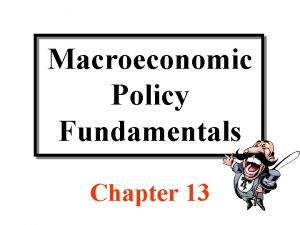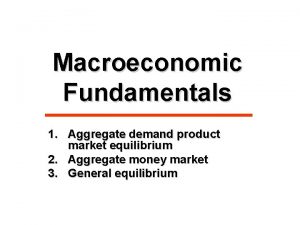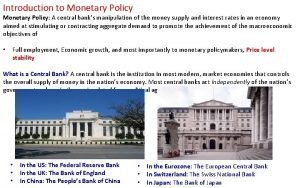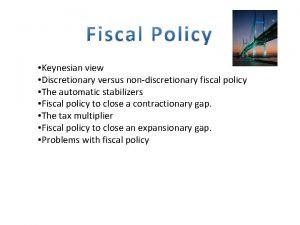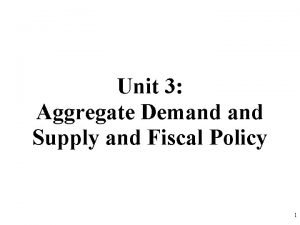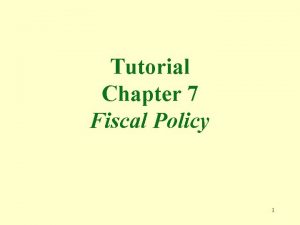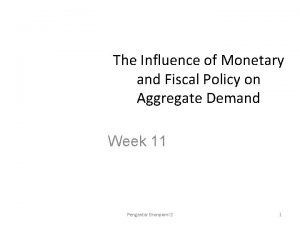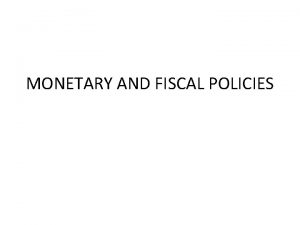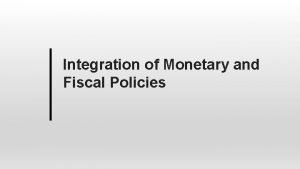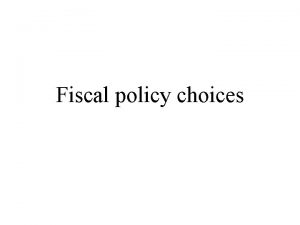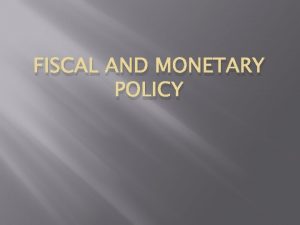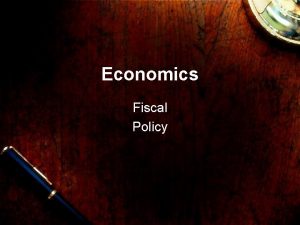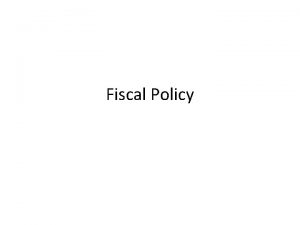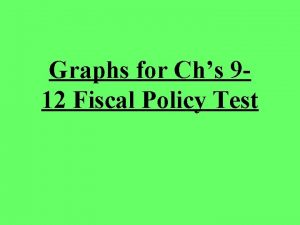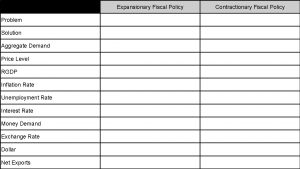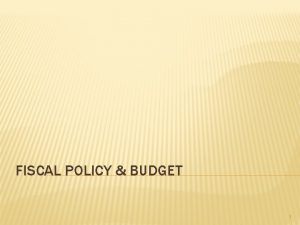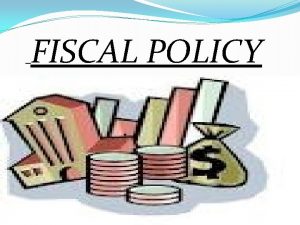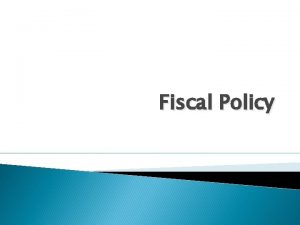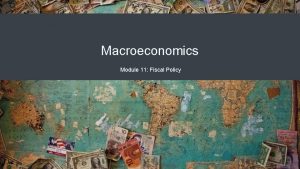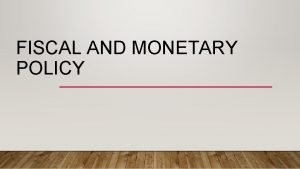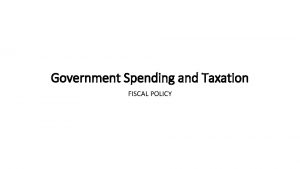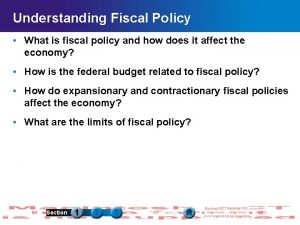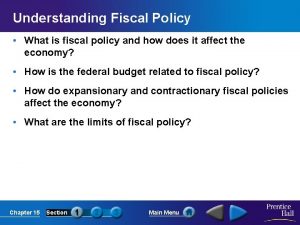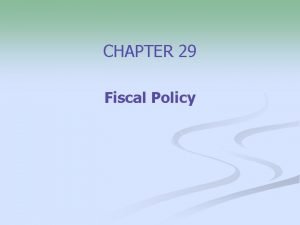Discussion of Forni and Pisanis Expansionary Fiscal Policy





















- Slides: 21

Discussion of Forni and Pisani’s “Expansionary Fiscal Policy and the Trade Balance: Evidence from a Bayesian DSGE model for the euro area” by Giancarlo Corsetti (European University Institute and CEPR) 2 nd BANK OF ITALY CONFERENCE ON MACRO MODELING IN THE POLICY ENVIRONMENT Banca d’Italia 30 June-1 July, 2009, Rome, Italy This information is confidential and was prepared by Bain & Company solely for the use of our client; it is not to be relied on by any 3 rd party without Bain's prior written consent.

Pressing questions and recent debates • Fiscal policy - Size and sign of the multiplier (under what conditions)? Counterproductive? - Interaction with (conventional and unconventional) monetary policy - International spillovers (demand leakages and exchange rate)? Need for coordination? • But what is the transmission mechanism? Some recent VAR results have revived old debates (consumption multiplier) but also questioned received wisdom on the transmission mechanism: - Exchange rates: evidence of depreciation in response to positive spending shock for the US (and other countries) - (Interest rate) - Twin deficits: for the US, evidence is mixed. 2

What does the paper do • Drawing on Adolfson et al. (2007) and Coenen et al. (2008) use Bayesian open economy DSGE model to assess the quantitative effects of fiscal shocks in the euro area vis-à-vis a (relatively more closed) foreign region (with no spillovers from the home region) • Model is rich on the fiscal side (spending, taxes), and accounts for financial frictions including ‘hand-to-mouth consumers’ • focus on two key dimensions: trade balance and international prices (real exchange rates) • Preliminary, yet nice job! 3

Main results • Adds to skepticism on fiscal stabilization - Output multiplier almost never above one - Investment is crowded out in response to spending and transfers shocks, although is mildly crowded in by temporary reduction in taxes - Consumption multiplier are negative in response to temporary hikes of spending on final goods and taxes on final goods; contained if temporary public transfers - consumption response is strong in response to temporary reduction in labour and consumption taxes => Stress on the need for a sharper understanding of transmission (more later) • Specific contribution to debate - Find twin deficits for spending and transfers - Terms of trade appreciate in response to shocks to spending, transfers, capital income taxes (depreciates with cuts in wage and consumption taxes) 4

Focus of my comments: Exchange Rates • I focus on exchange rates. First some evidence. I draw from ongoing work with Gernot Mueller and Andre Meier. • VAR evidence on the response of Spending shocks (augmented Blanchard-Perotti) for the US: 5

More evidence • VAR evidence on the response of Spending shock for a sample of OECD countries (annual data) 6

What is at stake? Theory Which model predicts a real exchange rate (terms of trade) depreciation in response to spending shocks? • Not a new issue: dubbed embarrassing failure of the Mundell Fleming model, by e. g. Dornbusch 1980 • Should we amend the standard GE models? - F. Bilbiie; T. Monacelli and R. Perotti (among others) stress complementarity between consumption and employment. - M. Ravn, S. Schmidt-Grohe and M. Uribe emphasize ‘deep habits’ in government consumption. • Should we rethink the way we model fiscal policy? - Joint work with A. Meier and G. Mueller: stress on medium-term fiscal framework (spending reversals) 7

What is at stake? Empirics • Is depreciation specific to the US (UK, Canada and Australia, or to our sample average)? - Beetsma, Giuliodori and Klaassen report real appreciation for European countries - CMM provide some evidence that the transmission of spending is associated with appreciation under fixed exchange rates • Is depreciation a by-product of mis-specification? - However, depreciation seems to be detected also using Ramey’s approach to identification 8

A key question • Can (estimated) DSGE models like the one in the paper shed light on the above issues, both theoretically and empirically? • The model imposes lots of structure on the data. The question is whether it is given a change to let the data ‘pick the winner’ among alternative transmission mechanisms • In the specification proposed in the draft, transmission is textbook. In response to spending and transfer shocks: - Consumption by ricardian households is crowded out - Non-ricardian consume more but not enough to drive aggregate consumption up • Why? The standard answer is ‘wealth effects’. • But note that ricardian consumption rises in response to temporary cuts in consumption and wage taxes! 9

A theoretical reconsideration • In present discount value, the change in the tax burden due to the assumed temporary increase in spending and transfer is minuscule (zero in the tax experiments) • What matters is the change in the intertemporal price of consumption and investment • Consumption euler equation: Change in the real return on a very long-term zero coupon bond • With ricardian agent and a high degree of risk sharing, for a given the foreign monetary stance, this is mirrored by the rate of depreciation Þ consumption, long real rate, real exchange rate • In Figures 2 -5 of the paper, appreciation is mirrored by a fall in ricardians’ consumption • Interplay between fiscal shocks and asset prices 10

Spending reversals Let’s play the same theoretical tune in a different way • As an empirically promising instance, embed in the model endogenous dynamic correction of current deficits (actually in the paper, eqs. 19 -21) - Mix of cuts in spending (below trend) and rise in taxes (debt sensitivity of spending and taxes) If current spending shocks are partially reversed over time • Anticipation of future spending cuts tends to lower future short real interest rates • If prices are flexible, current long real rate rises nonetheless: consumption of ricardian households fall • With nominal rigidities, under a Taylor rule larger adjustment in output: current long real rate may fall: consumption of ricardian households rise 11

Exogenous spending shocks/or no reversal 12

Endogenous fiscal policy: reversals 13

Spending reversals: flex price 14

Spending reversals: nominal rigidities 15

Including hand-to-mouth consumers 16

Taking stocks • Explore more the issue of endogenous debt correction dynamics • There is empirical evidence on debt sensitivity of spending (fiscal rule) • For the US, one can estimate coefficients between -. 02 and. 03 • The model does pick this up for the euro area. But effect is swamped by autoregressive coefficient 17

Matching impulse responses (US) 18

More to be done (policy and theory) • Endogenous dynamic of budget (tax and spending) policy has direct bearing on policy • Addresses issues raised by zero bound (see Christiano Eichenbaum and Rebelo; Eggertsson) • The model could be extended along other lines - Non separability (Bilbiie, Monacelli-Perotti effects) - Deep habits • Report long rates! 19

Only a word on twin deficit/divergence • Difficult issue raised by Kim and Roubini. Once again: - Faulty theory? - Faulty empirical specification? • Once again, as is the model is geared towards generating twin deficits 20

Conclusion • Authors have setup a very good framework to address key issues in the current debate on fiscal policy • Results so far suggest that textbook model of fiscal transmission can somehow frame the data for the euro area - But what is the measure of success? • Yet the model could do much more --- embed alternative transmission channels debated by recent literature • Looking forward to see future versions of it 21
 Graphing monetary and fiscal policy interactions
Graphing monetary and fiscal policy interactions Example of expansionary fiscal policy
Example of expansionary fiscal policy Contractionary monetary policy
Contractionary monetary policy Expansionary monetary policy flow chart
Expansionary monetary policy flow chart Expansionary money policy
Expansionary money policy Expansionary money policy
Expansionary money policy Example of medium of exchange
Example of medium of exchange Horno zucchelli forni manual
Horno zucchelli forni manual Vijaya rana
Vijaya rana Gli etruschi erano abili
Gli etruschi erano abili Unit 3 aggregate demand aggregate supply and fiscal policy
Unit 3 aggregate demand aggregate supply and fiscal policy Unit 3 aggregate demand aggregate supply and fiscal policy
Unit 3 aggregate demand aggregate supply and fiscal policy Discretionary vs non discretionary fiscal policy
Discretionary vs non discretionary fiscal policy Unit 3 aggregate demand aggregate supply and fiscal policy
Unit 3 aggregate demand aggregate supply and fiscal policy Galloping inflation
Galloping inflation Example fiscal policy
Example fiscal policy Fiscal policy practice
Fiscal policy practice Components of fiscal policy
Components of fiscal policy Crowding out effect of fiscal policy
Crowding out effect of fiscal policy Instruments of fiscal policy
Instruments of fiscal policy Instruments of fiscal policy
Instruments of fiscal policy Fiscal policy ib economics
Fiscal policy ib economics




